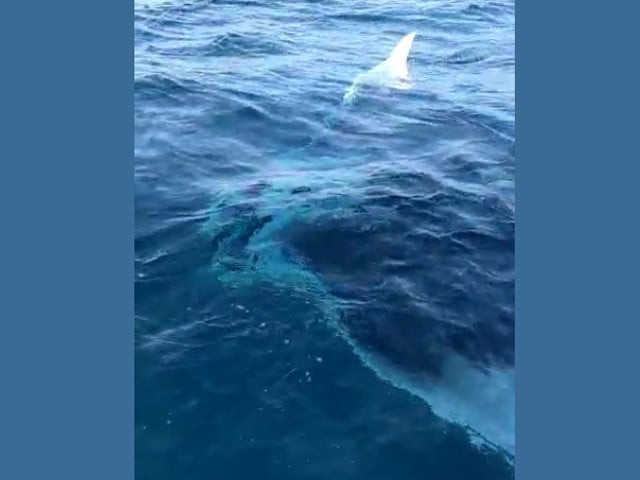WATCH: Giant mantas spotted off Karachi coast after six years
Despite being relatives of sharks, giant mantas are harmless animals that feed on small shrimps

Two giant manta rays, species that are a relative of the shark and stingray, were videoed swimming along the vessel captained by Samad Bilwani and shared by Zahid Maker, a member of Board of Director of WWF-Pakistan, in the southwest of Karachi in the Arabian Sea on Saturday.
This species, recently declared "endangered" by the IUCN and added to the IUCN red list, is known to commonly occur in Pakistan, but is now becoming extremely rare, a WWF-Pakistan statement said on Sunday.
According to the statement, the last sighting of the giant manta, scientifically known as Mobula birostris, was in the offshore waters north of Churna Island in October 2016.
Read more: WWF-Pakistan calls investing in green businesses
Although not directly targeted by fishing activities in Pakistan, a large number of the giant mantas get entangled in gillnet fisheries. However, their numbers declined over the last 20 years.
Prior to the creation of Pakistan, giant manta rays and whale sharks were targeted in recreational fishing in the offshore waters of Cape Monz and Churna Island. Details of a number of such hunting trips are published in newspapers and journals from the era.
"These two giant mantas were spotted in the offshore waters 50 nautical miles south of Karachi. It is extremely rare to see two giant manta rays together," the statement said.
Giant manta observed in offshore Waters of Karachi after 6 Years, declared ‘endangered’ by the IUCN.
— Sameer Mandhro (@smendhro) March 6, 2022
These two giant mantas were spotted in the offshore waters 50 nautical miles south of #Karachi. It is extremely rare to see two giant manta rays together. pic.twitter.com/oaKKrOD5uD
Despite being relatives of sharks, giant mantas are harmless animals that feed on small shrimps which are known to occur abundantly in the offshore waters of Pakistan.
According to Zahid Maker, it is amazing that these gentle giants encircled the boat, coming to the surface and swimming along the boat, presenting an amazing sight to behold. In many countries like Maldives, Thailand, Costa Rica, Fiji and Mozambique, recreational dives are arranged to allow swimming with giant mantas.
Also read: Rare snow leopard cubs spotted in northern Pakistan
According to Rab Nawaz, Senior Director Conservation Biodiversity, WWF-Pakistan, mantas and mobulas are an important part of the marine ecosystem of Pakistan.
In 2012, for the first time in Pakistan, WWF-Pakistan initiated detailed research and conservation work of these important marine animals and collected information about the distribution, abundance, and biology of these animals.
Taking these studies into consideration, and fearing their disappearance from Pakistan, WWF-Pakistan persuaded provincial fisheries departments to declare them species that are not allowed to be fished and marketed in Pakistan.
Through these efforts, the provincial governments of Sindh and Balochistan have notified laws for the protection of these species, prohibiting the catch, landing and sale of all species of mobula and manta rays in Pakistan.
According to Muhammad Moazzam Khan, Technical Adviser WWF-Pakistan, seven species of devil rays are found in Pakistan including reef manta ray (Mobula alfredi), giant manta ray (Mobula birostris), long horned mobula (Mobula eregoodoo), Kuhl’s devil ray (Mobula kuhlii), giant devil ray (Mobula mobular), Chilian devil ray (Mobula tarapacana) and bentfin devil ray (Mobula thurstoni). Of these, reef manta ray (Mobula alfredi) is the rarest and was last seen in Pakistan in 1964 when it was caught in the offshore waters of Pasni, Balochistan, whereas devil ray (Mobula mobular) used to commonly occur in Pakistan and was caught on a commercial scale.
Although there are no aimed fisheries for these gentle giants, they were frequently caught by gillnetters operating in the coastal and offshore waters of Pakistan. Species of mobula and manta rays are facing serious threat of extinction because they reach sexual maturity relatively late in life, giving birth to a single offspring every few years. They do not look after or defend their young and the offspring are vulnerable when they are small and may not survive.
According to Rab Nawaz, mainly because of fishing pressure, the population of manta rays is decreasing at an alarming rate in Pakistan. Their population is also seriously affected by habitat degradation and pollution and there is a need to create awareness amongst fishermen, as well as the general public, about the protection of these species as they are important national assets and a part of marine diversity in Pakistan.
Muhammad Moazzam Khan stressed the need for declaring Churna Island as a marine protected area (MPA) as it is known to be the last abode of giant manta and other megafauna – whale shark, sunfish, whales and dolphins.



















COMMENTS
Comments are moderated and generally will be posted if they are on-topic and not abusive.
For more information, please see our Comments FAQ